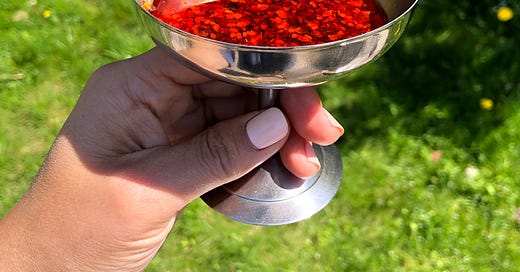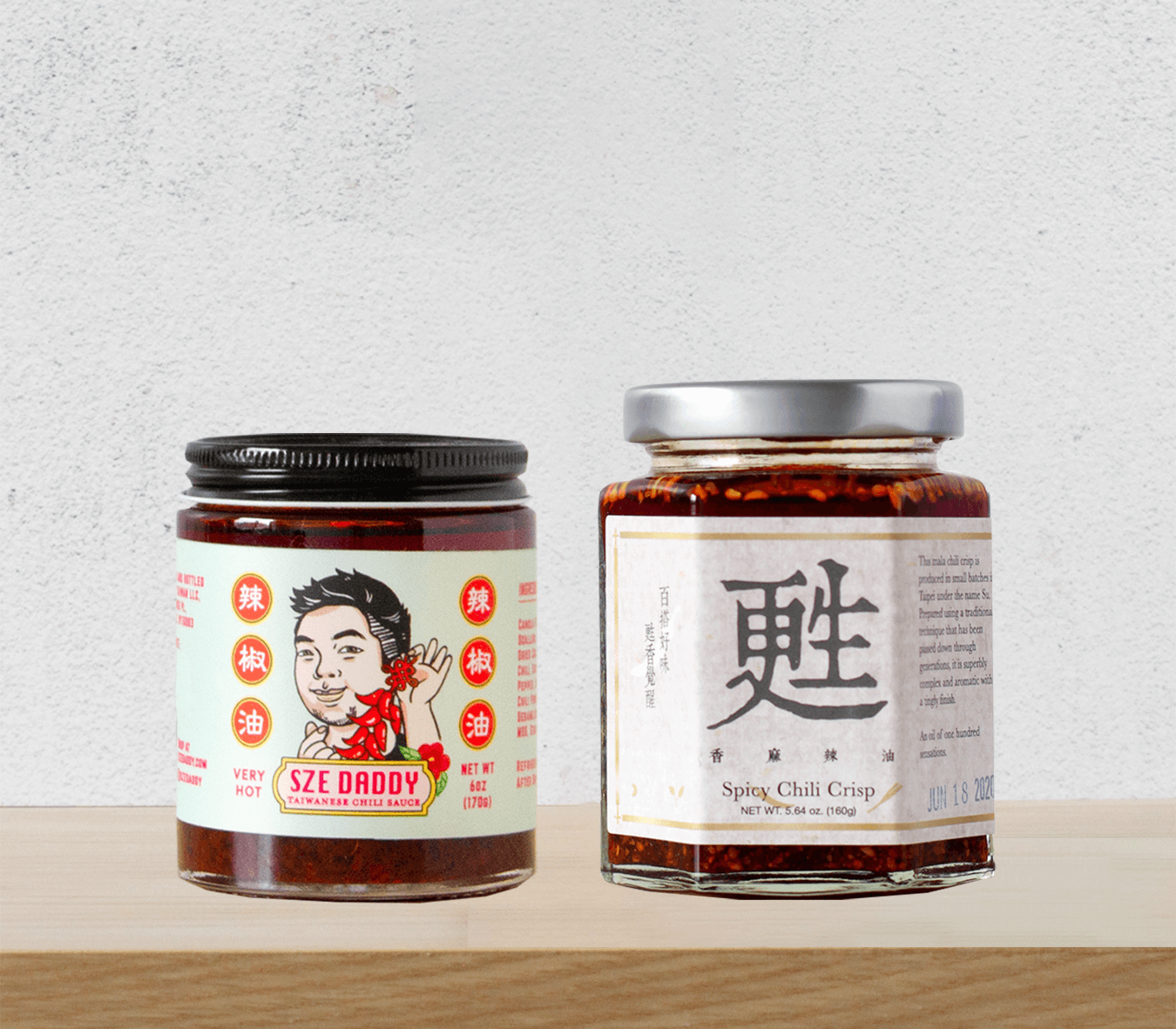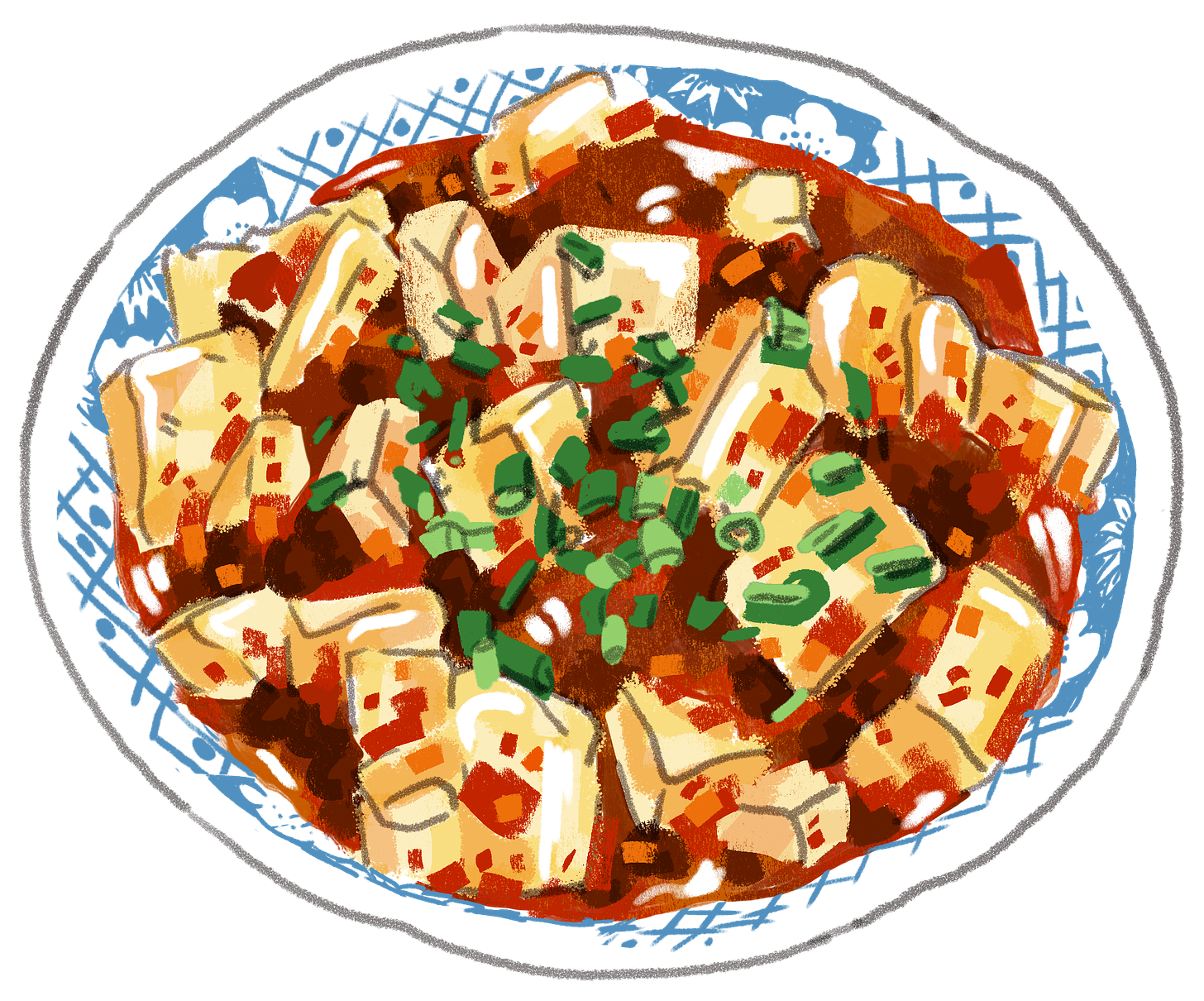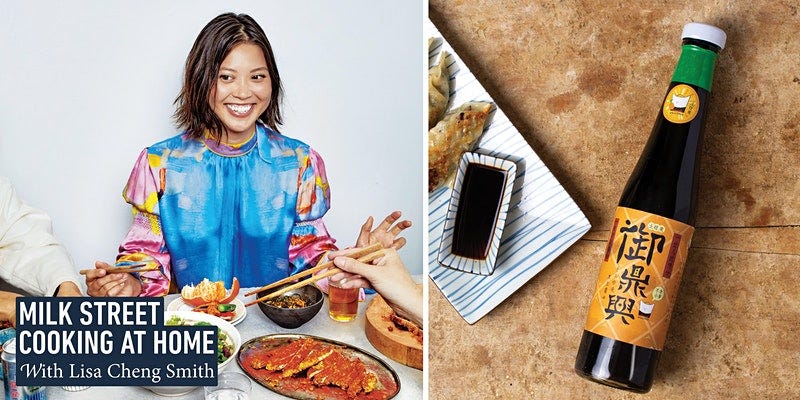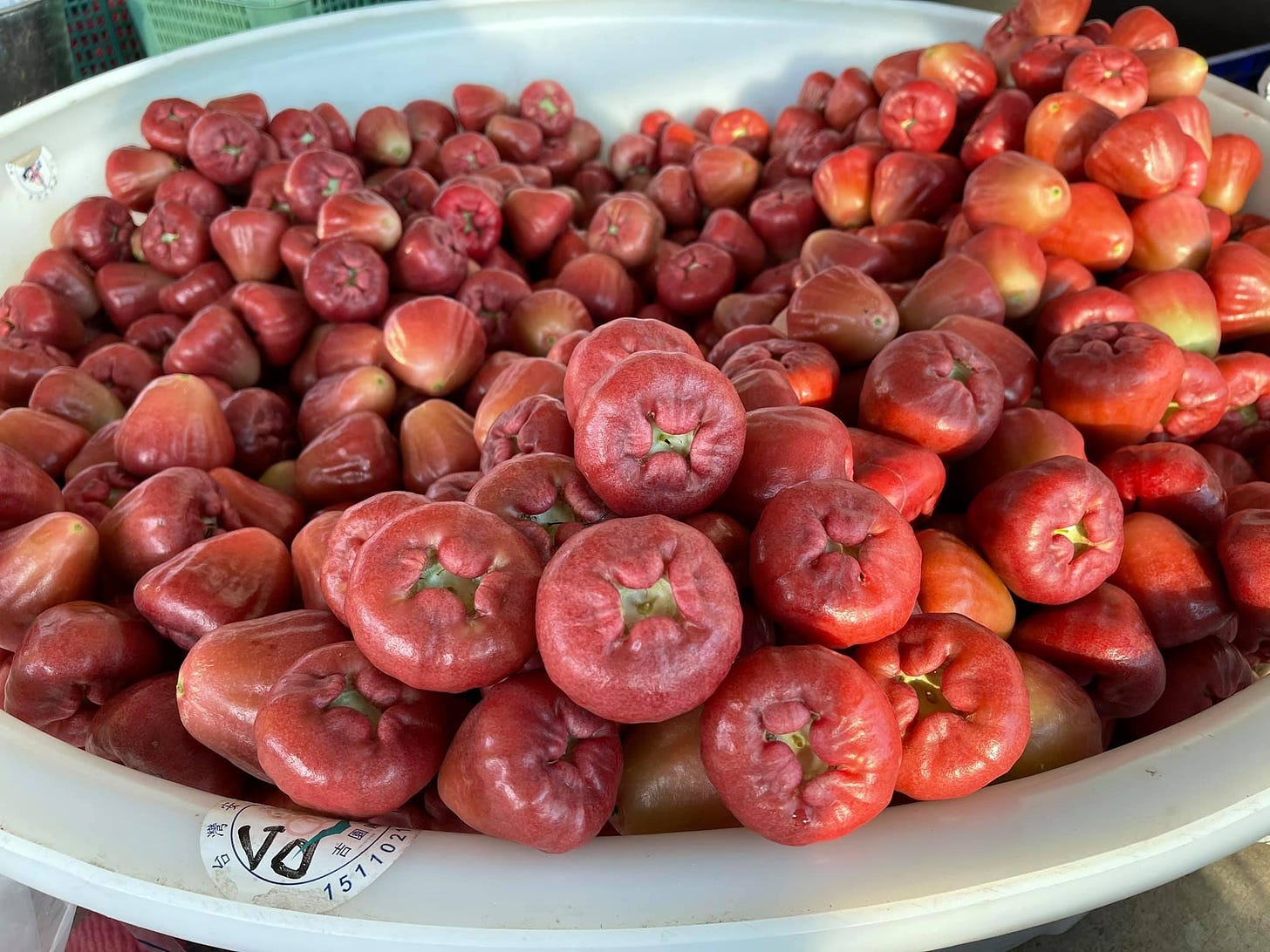This is Yun Hai Taiwan Stories, a newsletter about Taiwanese food culture by Lisa Cheng Smith, founder of Yun Hai Taiwanese Pantry.
This month, I spend a little time promoting chili crisp pluralism and reintroducing Chen Yu Chao’s Mapo Tofu Recipe. Next month, I’m joining a panel discussion on artisanal soy sauce and teaching a class on Taiwanese style cold-dressed dishes for the hottest days of summer. Scroll all the way down for a new Kombucha discovery and the final results of our dried fruit Kickstarter.
辣椒油, 油潑辣子, 香辣脆油辣椒
Fragrant, Spicy, Splashy, Crispy
It’s AAPI heritage month, and I can’t think of a topic more appropriate to discuss than chili crisp (known in Chinese as la jiao you 辣椒油 or chili oil). These oils carry ancestral flavors across time and space; each formulation is imbued with the gustatory preferences of our previous generations. The internet tells me chili crisp is a pandemic trend, but really it’s one of the most essential ingredients in the arsenal.
We’ve been included in several recent web roundups of chili crisps, each one describing which ones are best or how to select. The authors focus on the texture of the crisp, the flavor-forwardness of the ingredients, how spicy they are, varying umami levels, and etc. They’re not wrong to evaluate this way, but it’s difficult to quantify something unquantifiable.
Chili crisp is like perfume, different on every person, on every dish, at every temperature. It’s transportive, capturing the full essence of each component ingredient, transformed by heat and combined in effect. Oil is a perfect carrier of complexity, and our tongues and mouths are capable of perceiving sensations and flavors beyond the reach of words.
A bad chili crisp is dull, heavy, and simple to the senses. A good one is a narrative.
How do you describe an ingredient that behaves differently with each bite? How do you describe a scent that changes with the wearer’s skin chemistry? My favorite fragrance review site, Perfume Area, describes Le Labo’s Ambrette 9 fragrance in the following way:
In anticipation of a nice meal, root vegetable applies musk with a bubble wand. The first course is corn sorbet for a baby served in a plastic scallop shell. The main course is a demonstration of adorable lifehacks which are ultimately of no consequence to your true destiny. Dessert consists of pear and apple cordials poured in an hourglass that has been laterally split in two.
Could we apply the same poetic logic to chili crisp (or all food really)? Should descriptions read more like whiskey tasting notes (tire fires, parma violets, squid ink, vanilla) and perfume reviews than condiment labels?
To sort through some of your lingering questions about chili crisp, please enjoy this roundabout FAQ.
Q. What is Chili Crisp?
This question usually comes from people that have been calling this stuff chili oil their whole lives. One day, they woke up in a parallel universe surrounded by chili crisp instead. They aren’t victims of a multi-dimensional split (I’m a Berenstein Bears believer, look it up), just market forces.
This name confusion gets to the heart of how difficult it is to translate and conventionalize Chinese ingredient names. When figuring out how to present Su Chili Crisp to English speaking audiences, I referenced the label of the most well known brand—Lao Gan Ma. They make many chili oils and crisps, but the most popular version, “香辣脆油辣椒” or “fragrant spicy crispy oil hot sauce” is translated on their label as “Spicy Chili Crisp.” Trying to keep to the precedent, I translated my product as “Su Chili Crisp” to indicate it was a familiar alternative to the old standby. It seems that much of the chili oil world did the same. An entire class of ingredient defined by the translation of one variety in the Lao Gan Ma lineup; move over Kleenex.
In Chinese, this ingredient is most commonly called 辣椒油 (lajiaoyou, chili pepper oil) or 辣油 (layou, spicy oil), used interchangeably. Different makers add flair to the names, usually indicating something about the flavor, region, or preparation method. Su Chili Crisp in Chinese is called 香麻辣油 (or “fragrant mala spicy oil”). In Sichuan, similar products are known as 紅油 (“red oil”). They are also called 紅油辣子 (“red oil peppers”), or 油潑辣子 (“oil splashed chili peppers”). Modifiers like “fragrant”, “spicy”, and “crispy” are used almost poetically, in different word orders, to suit the characteristics of each formula and the perspective of the maker. “Crispy” is actually not an integral part of the name, and doesn’t appear in most variations. Some 辣油 don’t have any sediment at all; most do, but it isn’t typically called out.
Q. But really, what’s Chili Crisp?
Ok, legitimate question. Chinese/Taiwanese style chili oils are, in simplest terms, a blend of dried chili peppers, aromatics, spices, and other bits of flavoring sizzled in hot oil. The cooking process infuses the oil and transforms the ground bits into a delicious primeval flavor sediment. Variables include pepper types; the exact combination of herbs, aromatics, and spices; how all of the above are chopped and ground (if at all); the presence of salt, sugar, and MSG; and the temperature, type and proportion of the carrier oil. Color can vary wildly, with peak redness a trade secret (somewhat achievable at home with a second, lower temp fry of ground chili powder after the initial high heat infusion). Spice levels also vary. Some are not spicy at all, carrying forward only the beautiful popcorn-y flavor of the toasted pepper skin. Others are so hot that just a drop’ll do ya.
Q. Which one should I get?
I’m a chili crisp (née chili oil) pluralist. If we can have an aisle of ketchup, mustard and bbq sauce in our grocery stores, we ought to make room for a multitude of Chinese chili oils in our pantry. Ever been to a BBQ spot with 3+ sauces in squeezy bottles on the table? That’s how life should be.
I spent some time evangelizing poetic product descriptions. Let me attempt the same for the varieties I currently carry. We have plans to add more throughout the year, so let this be your introduction.
Su Chili Crisp
Absolutely pure; as complex and luminous as the smell of an evergreen forest. Endless taste permutations, colliding differently with each moment. So bright it makes water taste soft. Quantumly entangled with Orajel; also good for toothaches.
Sze Daddy
Like stepping into clay in a volcanic hot spring, except your feet are a spoon, the clay is a sweet garlic shallot sediment, and the spring is red oil. Soft like shacha, with a slow moving inertia that would keep it from spinning on axis in a centrifuge. Addictive like a pop song, 辣辣辣.
To encourage you to compare/contrast, we created a Chili Crisp bundle. Try both and write us a bizarre product review.
Mapo Tofu Recipe
This is the perfect time to share our go-to Mapo Tofu (麻婆豆腐) recipe, written by Chen Yu Chao, the maker of Su Chili Crisp. The recipe is different from most—no brown peppercorns required because the Su brings all mala. A shortcut, but better than a longcut.
This is a classic Sichuan dish; I grew up eating it at least once a week. It's spicy and zingy with a deep earthy sauce made from doubanjiang, fermented black beans, and chili oil. You can make this dish vegan by subbing with chopped mushrooms or a plant-based protein.
Su Chili Crisp doesn't have any added salt or sugar, so you can easily adjust the spice level without affecting the saltiness or sweetness of the dish. Serve with steamed rice and a simple green vegetable, like stir fried pea tips with garlic or blanched chinese broccoli with soy paste. Learn and riff.
June Food Events
I’ll be participating in two upcoming events in June. Not exactly prepared at the moment, but you bet I will be.
In Search of Great Soy Sauce: How a new artisanal movement is sweeping the Chinese food world
China Institute Food and Ideas Festival
June 16 at 7:30pm EDT
Online, Free
Why is Chinese food so seldom considered “haute cuisine?” Supermarket shelves are stacked with dozens of award-winning extra virgin olive oils, so where are the high-end, artisanal Chinese sauces? A new Chinese slow food movement—driven by next-gen foodies—is celebrating quality ingredients and traditional techniques, as young entrepreneurs are producing their own premium soy sauce, hoisin sauce, and chili crisp. Join the world’s top artisanal soy sauce maker in Taiwan, a Hong Kong-born New York restaurateur, a Shanghai-based food entrepreneur, and a Taiwanese food importer in New York, as they explore the rise of a new back-to-roots movement in Chinese cuisine.
I’m participating in this event alongside Yi-Cheng Hsieh, the third generation soy sauce brewer we work with. Tune in for him, not for me!
Cooking at Home with Lisa Cheng Smith: Taiwanese Dishes for Summer
Milk Street
June 19th, 12:00pm-1:15pm EDT
Online, Ticketed
The dog days of summer are the time to enjoy the season’s bounty—but hopefully without firing up the range. Cold-dressed side dishes, prepared with fresh produce and a minimum of heat, are present at many summer meals in Taiwan. Join Lisa Cheng Smith, of Yun Hai Taiwanese Pantry, as she shows you how to make three versatile dressings—a peanut/sesame sauce, a gingery soy paste dip, and a spicy salad dressing—and how to use them—in noodles, with tomatoes, and as a spicy accompaniment for any of the fresh produce from the farmers market or your garden. With these dressings in your arsenal, you’ll be able to improvise a refreshing Taiwanese dinner appropriate for the hottest of summer nights.
Yun Hai newsletter subscribers get 15% of the ticket price of $24.95. Use code YUNHAIMS or hit the link below.
Taiwanese American Business of the Month
Happy Gut Sanctuary in Rochester, NY
This past weekend I had the pleasure of visiting Happy Gut Sanctuary in Rochester, NY, a specialty tea fermenter (read: kombucha brewer). The business is owned by Catt Hsu and Rob Heffner, who started brewing out of their home as a way to improve their gut health. They recently opened a new space, where they ferment teas, sell growlers to a dedicated customer base, and serve tasting flights. They create their kombucha flavors purely from ingredients added pre-fermentation—the brew is not changed or augmented once fermentation begins. Many of their brews are purely tea ferments with no added flavorings; I was surprised at how fruity some of these were, with perfume-y notes of lychee, peach and mango but not in that lip balm way.
I was delighted to see kombucha referred to by the Chinese name on their menu, 茶菌 (cha jun). I picked up a bottle that was fermented with raw wild honey instead of sugar and have been enjoying it every morning since.
Catt told me how she perfects her recipes: she tries to use as little sugar as possible, pushing the ferment to an almost vinegar-like state in some instances. The teas all ferment differently; she uses varieties that are transformed by her method into something delightful, relying on the flavors within the tea and the culture. They have brews with added herbs and aromatics, too (hemp flower, yes) that are equally good.
9x Funded on Kickstarter
Last month we closed out an amazing Kickstarter campaign with 1117 backers and over $113,000 dollars raised. The campaign is in the top 2% of all Kickstarter food projects ever, and, most importantly, we are able to purchase over 12 tons of fruit from Taiwanese farmers.
This success started with you, our newsletter subscribers. You were the first to find out about the project and spread news of it far and wide. All our backers found us with no prearranged press, no ad spend, and no expensive visual assets. Thank you so much for sharing our story and all your support. The fruit will be available on our website in the fall. We’ll announce it here when it arrives.
慢慢走,
Lisa Cheng Smith
If you enjoyed this newsletter, please share it with friends and subscribe, if you haven’t already. We email once a month, sometimes more. For more Taiwanese food, head to yunhai.shop, follow us on instagram and twitter, or view the newsletter archives. If you’d like to see a topic covered or have a burning question that needs an answer, please leave us a comment.

